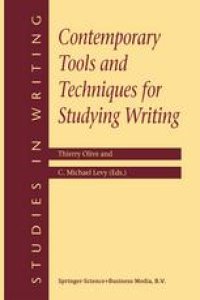
Ebook: Contemporary Tools and Techniques for Studying Writing
- Tags: Cognitive Psychology, Artificial Intelligence (incl. Robotics), Learning & Instruction
- Series: Studies in Writing 10
- Year: 2002
- Publisher: Springer Netherlands
- Edition: 1
- Language: English
- pdf
111 With some pride I hereby introduce the 10 volume in the Studies of Writing book series. This volume aims to be a tool-book for writing research. In my opinion, the editors and authors of this volume succeeded in this endeavor. Four guiding questions are answered in all chapters on online-techniques. How to ... The key to such a book is providing insight in the decisions researchers make when developing 'tools and techniques'; such information is not found in jour nal articles and in the best case hidden in technical reports. This book provides read ers with detailed information about the ins and outs of various online techniques. When to ... Another contribution of this tool-book is to provide insight into when the 'tool' can be used, in other words, to relate the tool or technique to the theoretical claims about the writing process or cognitive processes underlying writing processes. Theory, methodology, tools and techniques, handling data and interpretation form a coherent unit. When not to ... There is no cow without a spot' (Dutch: er is geen koe zonder vlekje) is the literal translation of a Dutch expression. Techniques/tools have their limitations, and their problems: in applying them, and/or handling or interpreting the data they produce. In a book like this, researchers took the opportunity to provide readers with a look behind the curtains, in the process of research. Scientific, critical reflection is one of the strong features of this book.
This book brings together methods designed by psychologists, linguists, and practitioners who aim to study writing both within the laboratory and the workplace. The methods presented link writing research with investigations of working memory, automatic semantic analysis, and writing in the workplace. Unlike previous volumes on writing, the primary focus of this book is upon the computer-based techniques and methods available today that enable and foster new systematic investigations of writing theories and processes.
The main target audience for this volume is writing professionals, including people who study writing processes and products, teachers of writing, as well as those, like journalists, whose careers depend on managing multiple constraints and audiences for their work.
Most of the software mentioned in this book is available free of charge on the website: http://www.psychologysoftware.com.
This book brings together methods designed by psychologists, linguists, and practitioners who aim to study writing both within the laboratory and the workplace. The methods presented link writing research with investigations of working memory, automatic semantic analysis, and writing in the workplace. Unlike previous volumes on writing, the primary focus of this book is upon the computer-based techniques and methods available today that enable and foster new systematic investigations of writing theories and processes.
The main target audience for this volume is writing professionals, including people who study writing processes and products, teachers of writing, as well as those, like journalists, whose careers depend on managing multiple constraints and audiences for their work.
Most of the software mentioned in this book is available free of charge on the website: http://www.psychologysoftware.com.
Content:
Front Matter....Pages I-IX
Real Time Studies in Writing Research: Progress and Prospects....Pages 1-8
Writing with Concurrent Memory Loads....Pages 9-29
The Triple Task Technique for Studying the Process of Writing....Pages 31-59
On the Cognitive Status of Pauses in Discourse Production....Pages 61-87
Studying Writers’ Revising Patterns with S-Notation Analysis....Pages 89-104
Progression Analysis (PA): Investigating Writing Strategies in the Workplace....Pages 105-117
On-Line Methodologies for Studying the Written Production of Isolated Words: A Brief Overview....Pages 119-129
Potential Applications of Latent Semantic Analysis to Writing Analysis....Pages 131-144
Back Matter....Pages 145-163
This book brings together methods designed by psychologists, linguists, and practitioners who aim to study writing both within the laboratory and the workplace. The methods presented link writing research with investigations of working memory, automatic semantic analysis, and writing in the workplace. Unlike previous volumes on writing, the primary focus of this book is upon the computer-based techniques and methods available today that enable and foster new systematic investigations of writing theories and processes.
The main target audience for this volume is writing professionals, including people who study writing processes and products, teachers of writing, as well as those, like journalists, whose careers depend on managing multiple constraints and audiences for their work.
Most of the software mentioned in this book is available free of charge on the website: http://www.psychologysoftware.com.
Content:
Front Matter....Pages I-IX
Real Time Studies in Writing Research: Progress and Prospects....Pages 1-8
Writing with Concurrent Memory Loads....Pages 9-29
The Triple Task Technique for Studying the Process of Writing....Pages 31-59
On the Cognitive Status of Pauses in Discourse Production....Pages 61-87
Studying Writers’ Revising Patterns with S-Notation Analysis....Pages 89-104
Progression Analysis (PA): Investigating Writing Strategies in the Workplace....Pages 105-117
On-Line Methodologies for Studying the Written Production of Isolated Words: A Brief Overview....Pages 119-129
Potential Applications of Latent Semantic Analysis to Writing Analysis....Pages 131-144
Back Matter....Pages 145-163
....